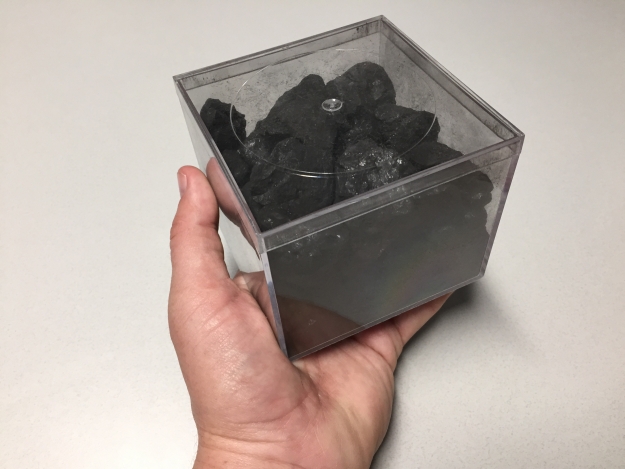By David Dodge and Duncan Kinney

Austin Brown of the National Renewable Energy Lab keeps this hunk of coal on his desk as a reminder of what a kilowatt-hour of electricity actually is. Burning this softball sized piece of coal will give you roughly a kilowatt-hour worth of electricity. Photo courtesy of Austin Brown NREL.
We’re very lucky here at Green Energy Futures to write about clean energy. But while we are privileged to do what we do we are also guilty—guilty of using jargon.
It’s a danger that any writer runs into when you cover a beat as closely as we do. A lingua franca develops between you and your subjects where everyone assumes that everyone else knows what’s being talked about.
Well that’s just not right. We want to explore some of the foundational terms we use on a regular basis and we wanted to start with one that’s on your electricity bill.
What exactly is a kilowatt-hour anyway?
To figure out what exactly a kilowatt-hour actually is we contacted Austin Brown, an energy analyst with the National Renewable Energy Lab down in Washington, DC.
“Even researchers who do this don’t really know what a kilowatt-hour is,” says Brown. “The only reason we have any bearing on it is because we pay our utility bills so we know that a kilowatt-hour costs a little over 10 cents. But in terms of how much energy it is — that’s really hard to know.”
Well that’s comforting. And thankfully Brown has a handy way of making a kilowatt-hour feel real.

Austin Brown is an energy analyst with the National Renewable Energy Lab’s office in Washington, DC. Photo courtesy of NREL
“I actually have a kilowatt-hour on my desk. I have a small plastic box that has one kilowatt-hour’s worth of coal in it, and that helps me remember how much it is. It’s about the size of a softball,” says Brown.
The equivalent of one kilowatt-hour’s worth of electricity from natural gas is a balloon full.
So if the average Alberta residence uses 7,200 kilowatt-hours a year you can now visualize your annual energy use based on Alberta’s electricity mix which is 90 per cent coal and natural gas.
Picture a ball pit full of several thousand softball sized pieces of coal. Directly above that there is another couple thousand balloons filled with natural gas. And then off to the side you’d have 10 per cent of your electricity represented by a mix of wind, hydro and biomass equivalents.
Knowing there are real, physical things behind those numbers on your electricity bill is a whole lot more helpful.
Houses per megawatt and capacity factor
“This new wind/hydro/biomass/solar project will power 125,000 homes.”
How many times have you read this on our website when talking about a new energy project? It’s super common, but what does it actually mean? A megawatt is quite literally one million watts but how do you get from that to powering a certain amount of homes?
We tracked down John Esaiw to help us out. He’s the director of Commercial and Market Services at AESO, Alberta’s independent electric system operator.
“We have a rough calculation here, and this isn’t perfect. But we estimate that one megawatt is enough energy for about 1,250 average homes,” says Esaiw.
Austin Brown uses this metric all the time, customizing it for the various regions and technologies. He knows its limitations but likes it as a way to put projects into terms that people understand.
But not all megawatts are equal. A 100-megawatt wind farm isn’t going to produce as much energy in total as a biomass or coal plant because of the variable nature in which wind farms produce energy.

John Esaiw is the director of commercial and marketing services at Alberta’s Electricity System Operator. Photo courtesy of AESO
“So, the average wind farm in the province right now is running at a 30 per cent capacity factor, which means over the course of an entire year, a 100-megawatt wind farm would be producing, on average, 30 megawatts,” says Esaiw.
Let’s use a real life example. For the wind farm inside the city limits of Medicine Hat, Alberta, its six-megawatt size times the capacity factor of 30 per cent yields 1.8 megawatts. We take multiply this actual production by 1,250 houses per megawatt and we get 2,250 homes. Medicine Hat rounds this off to 2,000 homes on their website.
Now let’s bring this idea home. If you have a home and you are using the Alberta average of 7,200 kilowatt-hours of electricity per year, you will need a six-kilowatt solar system to be net zero in your electricity use. Without getting too far into the math, the solar system’s capacity factor is 13.1 per cent in sunny Alberta. So your average home with average energy energy use would need about 24 (250-watt) solar modules or a six-kilowatt system.
Now you can visualize your energy use as a couple of thousand softballs of coal and balloons of natural gas plus a little wind power or if you installed solar on your home it looks like 24 solar modules.
Think of capacity factor as the percentage of time over a course of a year that a power plant runs on average. This varies greatly. We have seen number for coal ranging from 60–85 per cent, geothermal at 70 per cent and landfill gas at 69 per cent, for example.
And that 1,250 houses per megawatt number is particular to Alberta. It changes across the world, and while it’s a useful contextual tool, it never hurts to ask some questions to find out what the assumptions are behind it.
So, if you catch us using any more jargon in the future don’t hesitate to leave a comment, fire us off an email or reach us on Twitter or Facebook.






